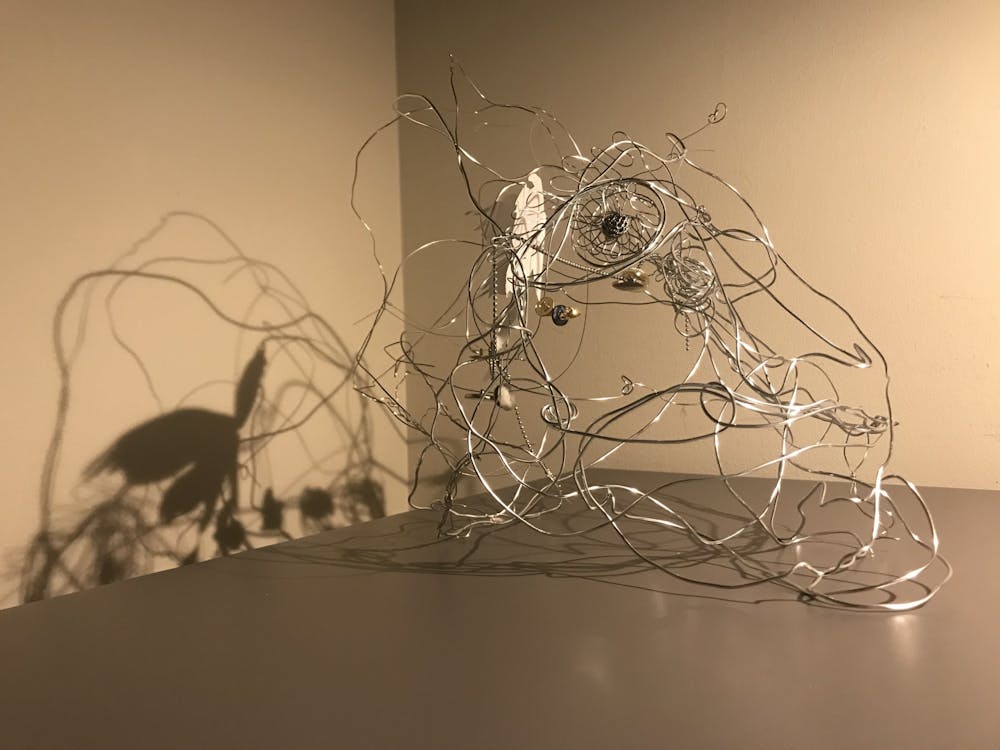In my 16 years of creating art, I have experimented with paint, ink, pen, markers, metal, foam, plaster, and more. To make art, I converse with my materials. Each one has a unique personality that inspires me to express myself in new ways.
To me, sculpture is the art of creating meaning in 3D space. Before coming to Princeton, I had yet to explore this artistic realm. Now, I am taking Professor Joe Scanlan’s introductory sculpture class and it feels as though I am learning to speak a new dialect.
On the first day of class, Professor Scanlan presented slides of artists documenting a walk, either through pictures of people walking, a screenshot of a traced path on Google Maps, or assembling a sculpture from objects found during a walk. One artist, Richard Long, tread a path into the grass between mountains over many months and then photographed his work. We also reviewed images of stick charts that the Marshallese used to navigate the seas.
The material forced me to question: We can walk with our legs, but can we walk with our minds? In an attempt to explore neural pathways and to investigate how memories and thoughts travel through our heads, I decided to make a sculpture of a person.
After acquiring a plastic branch, a film reel, various wires, and an assortment of glittering gold and silver buttons, I began sculpting, forming an angel with the materials. But as I added more and more ribbons to the scaffold and the dragonfly-inspired wings, my sculpture started to look cluttered.
The night before the assignment was due, I tore away the excess materials and sculpted the skeleton of the angel into a bust with one winking eye and an intricate head. All the while, I thought of Laniakea, a supercluster that means “immeasurable heaven” in Hawaiian. The feathery, luminous connections between the galaxies reminded me of our biological neural pathways, which inspired scientists to create the structure of artificial neural networks, a subset of artificial intelligence. How beautiful it is, I thought, that our universe on the large scale and our minds at their core look so similar.
I also added a paper butterfly to my sculpture to represent the soul. 庄周梦蝶 (Zhuāng Zhōu Mèng Dié) is an ancient Chinese idiom in which a man named Zhuāng Zhōu falls asleep and vividly dreams that he is a butterfly. When he wakes up, he is unsure about whether he was a man dreaming of being a butterfly, or if he is a butterfly dreaming of being a man.
The butterfly also represents the butterfly effect, which suggests that a butterfly flapping its wings can cause large changes in the world. Similarly, our thoughts, though seemingly as insignificant as a butterfly flapping its wings, will influence our actions and thus, shape the course of our lives.

To finish the sculpture, I strung buttons, which represented memories and ideas, onto chains, which represented the paths of our thoughts.
During my presentation, my classmates passed around my sculpture, and Professor Scanlan commented that it felt as if they were passing around my brain.
He was right. When I make art, I put much of myself into the piece. I infuse the materials with my thoughts and ideas. This makes me wonder: Am I my thoughts? Are my thoughts me? In any case, my art is a reflection of my internal state, of my inquiries to the world.
Art is a language like no other — it leaps across boundaries and passes the test of time with flying colors. If I can move another person with the sculptures and other artwork that I make, I will be happy.

Audrey Zhang is a Contributing Writer for the Prospect. She can be reached at az5221@princeton.edu, on Instagram at @shimmer_the_powerful.








